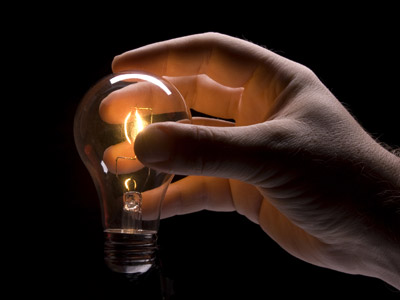The
Dark Absorber Theory

For years, it has been believed that electric bulbs emit light, but recent information has proved otherwise. Electric bulbs don't emit light; they absorb dark. Thus, we call these bulbs Dark Absorbers. The Dark Absorber
Theory and the existence of dark absorbers prove that dark has mass and is heavier than light.
First, the basis of the Dark Absorber Theory is that electric bulbs absorb dark. For example, take the Dark Absorber in the room you are in. There is much less dark right next to it than there is elsewhere. The larger the
Dark Absorber, the greater its capacity to absorb dark. Dark Absorbers in the parking lot have a much greater capacity to absorb dark than the ones in this room.
As with all things, Dark Absorbers don't last forever. Once they are full of dark, they can no longer absorb. This is proven by the dark spot on a full Dark Absorber. A candle is a primitive Dark Absorber. A new candle has a white wick. You can see that after the first use, the wick turns black, representing all the dark that has been absorbed into it. If you put a pencil next to the wick of an operating candle, it will turn black. This is because it got in the way of the dark flowing into the candle. One of the disadvantages of these primitive Dark Absorbers is their limited range.
There are also portable Dark Absorbers. In these, the bulbs can't handle all the dark by themselves and must be aided by a Dark Storage Unit. When the Dark Storage Unit is full, it must be either emptied or replaced before the portable Dark Absorber can operate again. Dark has mass. When dark goes into a Dark Absorber, friction from the mass generates heat. Thus, it is not wise to touch an operating Dark Absorber. Candles present
a special problem as the mass must travel into a solid wick instead of through clear glass. This generates a great amount of heat and therefore it's not wise to touch an operating candle.
Also, dark is heavier than light. If you were to swim just below the surface of the lake, you would see a lot of light. If you were to slowly swim deeper and deeper, you would notice it getting darker and darker. When you get really deep, you would be in total darkness. This is because the heavier dark sinks to the bottom of the lake and the lighter light floats at the top. The is why it is called light.
Finally, we must prove that dark is faster than light. If you were to stand in a lit room in front of a closed, dark closet, and slowly opened the closet door, you would see the light slowly enter the closet. But since dark is so fast, you would not be able to see the dark leave the closet. This is proof positive that the Dark Absorber Theory is true.
**********
Nový
vědecký objev: Pohlcovač tmy
Po léta se nám tvrdilo, že žárovky vyzařují světlo. Poslední výzkumy však ukázaly, že je tomu jinak. Žárovky nevyzařují světlo, ale zato pohlcují tmu. Proto se jim správně má říkat pohlcovače tmy.
Teorie pohlcovačů tmy dokazuje, že tma má hmotnost a je těžší a rychlejší než Světlo. Základem teorie pohlcovačů tmy je tvrzení, že žárovky pohlcují tmu. Vezmeme si pohlcovač tmy ve vašem pokoji. Jistě potvrdíte, že v jeho blízkosti je méně tmy než kdekoli jinde. Čím vetší pohlcovač, tím více tmy dokáže pohltit. Pohlcovače na parkovišti mají mnohem vetší kapacitu než pohlcovač ve vašem pokoji. Stejně jako všechny věci má pohlcovač tmy jen omezenou životnost. Jakmile se tmou naplní, nemá kam další tmu pohlcovat. To se projeví tmavou skvrnou, která je v plném pohlcovači jasně viditelná. Tma, kterou pohlcovače pohltí, jde pak dráty do energetických závodu, které ji likvidují, obvykle za pomoci fosilních paliv.
Primitivním pohlcovačem tmy je i svíčka. Nová svíčka má knot bílý. Po prvním použití zjistíte, že v důsledku pohlcené tmy knot zčernal. Dáte-li do blízkosti fungující svíčky tužku, zčerná také. Je to proto, že kolem ní proudila tma do svíčky. Nevýhodou těchto primitivních pohlcovačů tmy je jejich omezený dosah.
Existují i přenosné pohlcovače tmy. V nich má žárovka příliš malý objem, a musí se do její blízkosti proto instalovat odkladiště tmy, lidově zvané baterie. Jakmile se odkladiště zaplní, musí se vyprázdnit nebo vyměnit; potom muže pohlcovač opět fungovat.
Tma má hmotnost. Ta se projevuje třením při přechodu tmy do pohlcovače a toto tření pohlcovač zahřívá. Proto není radno dotýkat se pohlcovače v činnosti. Ještě vetší problémy jsou u svíčky: hmota tmy do ní musí proniknout pevným knotem místo průhledného skla. Tím se uvolňuje ještě více tepla a není proto vhodné sahat ani na fungující svíčku. Zahřívání pracujícího pohlcovače je pochopitelné. Stlačujete-li plyn, zahřívá se - a stejně se zahřívá i tma stlačovaná do drátu žárovky.
Tma je těžší než světlo. Plavete-li těsně pod hladinou, vidíte kolem dostatek světla. Ponořujete-li se hlouběji a hlouběji, všimnete si, že je kolem stále větší tma. Ve velké hloubce je tma úplná. To je proto, že těžší tma klesá ke dnu a lehčí světlo zůstává nahoře. Proto se také světlo a lehký v angličtině řekne stejně ...
Zbývá ještě dokázat, že tma je rychlejší než světlo. Postavíte-li se v osvětlené místnosti před zavřenou skříň a otevřete pomalu dveře, uvidíte světlo pomalu pronikat dovnitř. Tma je však tak rychlá, že ji nikdy neuvidíte prchat ze skříně ven.
Až tedy příště uvidíte žárovku, nezapomeňte, že to není světelný zdroj, ale naopak pohlcovač tmy.
| found
on the Internet photo © unknown |
